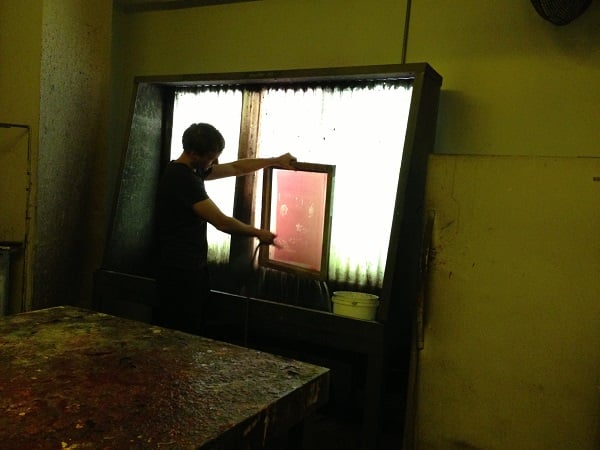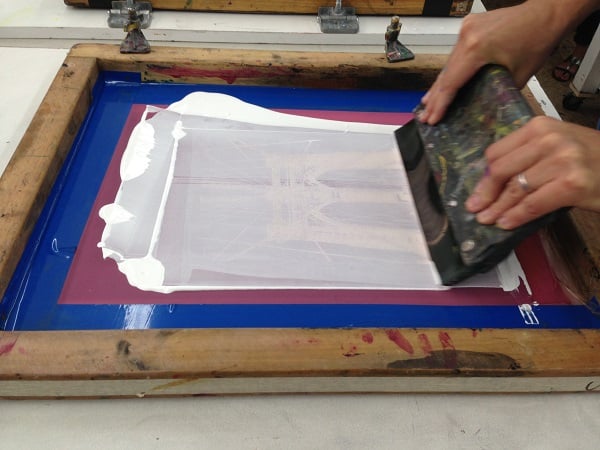Art World
artnet Hits the Studio: A Visit to the Lower East Side Printshop
The artnet team recently visited the Lower East Side Printshop for a printmaking demonstration.

The artnet team recently visited the Lower East Side Printshop for a printmaking demonstration.

Erica Trapasso, Rebecca Honts, and Conner Williams


The artnet team tries their hand at screen printing
Lower East Side Printshop is a premier non-profit New York City printmaking studio that supports Contemporary emerging, mid-career, and established artists in the creation of new work. Support includes studio facilities, time, and financial and technical assistance. Services include residencies—independent and collaborative—exhibitions, prints for sale, education in printmaking and career advancement skills, and peer-to-peer support.
With its exhibitions, open studios, education, and other public programs, the Printshop serves as a junction for artists, collectors, museums, galleries, and educational institutions to access and engage in Contemporary Art.
With over 160 artists served each year, the Printshop is the largest openly accessible printmaking workspace in the United States.
Recently, the artnet Price Database and Analytics teams paid a visit to the Printshop, where Master Printer Erik Hougen presided over a printmaking demonstration.
Hougen’s technical expertise is the practical complement to an artist’s vision. As a master printer and intaglio instructor, he considers himself to be one more tool available to the artist, working to seamlessly capture and convey the artist’s idea for how a piece should look and what it should communicate. He previously worked as a studio assistant for Takashi Murakami (Japanese, b.1962) and as a printer at Pace Editions, and he regularly returns to Pratt Institute, his alma mater, to teach graduate lithography.
Erica Trapasso and Rebecca Honts discuss their outing to the Lower East Side Printshop with artnet Auctions’ Contemporary Art and prints specialist Connor Williams.
Connor Williams: As members of the artnet Price Database team is there anything in your daily work that encouraged you to visit the Printshop?
Erica Trapasso: We’ve frequently discussed taking an educational excursion to learn more about the media we see coming into the artnet Price Database on a daily basis. Prints have always brought up some confusion as we prepare this auction information for the database, especially when dealing with the edition information. We see a lot of both Contemporary and Old Master print sales during auction season, and we wanted to have a better understanding of the different print media so that we can process auction data more accurately.
Rebecca Honts: We have a team of multilingual art historians who process every lot that goes into the Price Database for accuracy. While many on the team are also visual artists of some sort, we knew very little about printmaking. Like Erica said, printmaking is a very technical process—there are publishers, printers, and so many different terms related to the edition information, not to mention countless printmaking techniques! What better way to learn exactly what all these terms and techniques mean than to see and experience them in person?
CW: Did the participatory nature of the workshop meet your expectations?
ET: Yes. Editioning still seems to be the most confusing part of the printmaking process, but Erik assured us that there aren’t really any set-in-stone rules about how editions are labeled. Every artist and institution can make their own rules.
RH: The printmaking demonstration was exactly what I’d hoped it would be—part instruction and part demonstration. And it was a pleasant surprise when Erik gave us the chance to make our own prints and plates.

Erik rinses the screen with water using a power washer, revealing artnet’s original screen print design in the areas of exposed mesh where the ink can get through
CW: As a master printer, Erik Hougen possesses a broad range of expertise in printmaking. Were there specific printmaking techniques that he discussed?
ET: The demonstration broadly covered silkscreen printing and etching.
RH: Erik showed us different types of intaglio printmaking, including etching, engraving, drypoint, and aquatint. The great thing about intaglio prints is that they all start with the same sort of process—incising your design into a plate with various tools. How you choose to treat and print the plate then determines exactly what kind of printmaking process you end up with. It was really enlightening to see—and create—the same types of prints we see every day at work.
CW: What did you learn from your workshop experience that you had not previously known about printmaking? Was there anything surprising?
ET: There are a lot more steps to the printmaking process than I realized, especially with etchings. I also had no idea how closely the printer works with the artist in creating an edition. The printer will produce several prints before the artist approves one as the BAT (bon à tirer), which becomes the template for the edition.
RH: I’d never worked with any sort of intaglio printing before and, like Erica, didn’t realize how many opportunities an artist has to work and rework the plates before ever getting to the actual printing process. Most surprising for me was learning how a mezzotint is made—you basically have to hatch, cross-hatch, or stipple the entire copper plate and then use a burnishing tool to smooth out the lighter areas and create tones. I had no idea how labor-intensive this process was—and needless to say, we didn’t have time for Erik to demonstrate it to us!

To print the design, pull the squeegee at a 45-degree angle in one motion from top to bottom, applying even pressure
CW: Some artists are known for preferring one printmaking technique over another, for reasons of ease, labor intensity, the exploration of creative ideas, or the physical qualities of the work. Similarly, was there a technique that you favored?
ET: Making our own screen prints. Erik handed out transparent sheets for us to doodle on using marker and ink, which then became the design for the screen prints. The etching was fun too, but much harder. You definitely need artistic skill and patience to be an etcher.
RH: I really enjoyed the screen printing demonstration as well. It seems like such an accessible printing technique; and now I have a couple of artnet originals at home.
CW: Professional and amateur artists alike make visits to the Printshop. Each has different intentions with different results. How do you suppose your experience impacts your current work or appreciation of printmaking?
ET: I’ll absolutely keep my new-found knowledge of editions in mind when editing auction lots for the Price Database. Erik’s clarification that there are no steadfast rules in editioning was very helpful. I also found it insightful just to observe the different processes of printmaking and learn all the terminology that goes along with it. Overall, it was a very educational outing, and I hope we can do something like this again.
RH: When I encounter a print sale now, I am going to have a greater appreciation for the work, now that I know what goes into the process. Who knows, I may even be inspired to try some more printmaking of my own.

The screen is hinge clamped into the base, and the paper aligned with the image on the screen using metal tabs or tape to keep it in place (this is called the registration)—the design is now ready to be printed